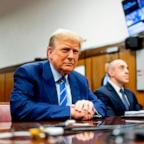ABC 2002: Third-Party And Independent Candidates
— -- From a media standpoint, one nice thing about third-party candidates is that they often make for good stories.
Candidates who don't have the major party committees overseeing their every move often feel free to flout the conventions of traditional campaigning.
Of course, another way of saying the same thing is that some of these candidates are just plain wacky.
Beyond that, however, even when they have little or no chance of winning themselves, these candidates make it possible for major-party contenders in close races to win with just a plurality of the vote.
In listing all the notable third-party candidates this cycle, we've ranked them here in order of the likelihood that they will have some effect on the outcome, even if only at the margins, and also with an eye toward good possible color.
1. Minnesota governor
State Senator Roger Moe (DFL)State Rep. Tim Pawlenty (R)Former Rep. Tim Penny (Independence Party)Ken Pentel (Green)
Former Democratic Congressman Tim Penny "has a good chance to win his race," wrote top political reporter David Broder in July.
Penny, we should note, is now a member of Jesse Ventura's Independence Party — a third-party candidate. Why is his potential victory cemented in Broderian prose?
Minnesota's two established political parties are weaker than they've ever been. The Democrat-Farmer-Labor party's base --farmers and labor — has either dwindled, in the case of the former, or matured, in the case of the latter. Blue-collar workers are as likely to choose Republican candidates as they are Democrats.
Meanwhile, the state Independent-Republican party has tacked to the right in recent elections. And the state's caucus-endorsement-nomination system ensures that activists within the party have greater sway over the nominees than rank-and-file voters. Often, candidates are chosen who are too beyond the mainstream for much of the state's electorate.
In this case, the major party nominees are not so extreme as they are not particularly strong or exciting, and that gives Penny an opening, making him the only minor-party candidate or independent on our list with a legitimate chance to win.
Ventura's legacy as an upset winner arguably will be stronger than his legacy as governor. Penny, on the other hand, is known statewide; has a wonkish policy background; is popular, affable, and moderate; and is earning enormous free media.
And Ventura's endorsement didn't hurt, though the degree to which it will help is not clear.
Like Ventura, Penny is a penny-pincher. He's also a decided centrist on cultural and social issues. He spent 12 years in Congress representing Minnesota's 1st Congressional District. His current running mate, another party-switcher (from Republican to Independence Party), is more liberal than he is, which helped assuage concerns that Penny might be too conservative for the party's moderate base.
The Green Party, which helped Ralph Nader get more than 126,000 votes in the state in 2000, has tapped Ken Pentel, a self-styled activist from Minneapolis, to run for governor. Though Pentel in 1998 got just over 7,000 votes (with $17,000 spent), party officials hope to capitalize on another three-way race.
This year, Pentel hopes to get public funding and predicts, without embellishment, that he will at least double his vote total from last time.
2. Wisconsin governor
Gov. Scott McCallum (R) Attorney General Jim Doyle (D)Ed Thompson (Libertarian)
Thompson is the brother of HHS Secretary Tommy G. Thompson — himself, of course, a former longtime governor of the state. Ed Thompson got into politics four years ago when he waged a public campaign against state gambling laws. (His house of video poker had been raided.) He supports a thin version of the Libertarian platform: medical marijuana, lower taxes, less burdensome regulation, and school choice.
Thompson owns Mr. Ed's Tee Pee Supper Club in Tomah, and is currently the mayor of that small city.
Depending on who asks the question and how, Thompson polls as high as 10 percent in a three-way general election race with McCallum and Doyle. And Wisconsin does have same-day voter registration, which lends itself to late-October populist upswings — just ask Jesse Ventura. Thompson is outspoken, colorful, and likable — all in contrast with McCallum, who is seen by the media, and by many voters, as stand-offish.
Incidentally, there are three other minor candidates whose names might appear on the ballot, pending the result of the primaries and their signature gathering requirements.
3. New York governor
Gov. George Pataki (R)State Comptroller Carl McCall (D)Tom Golisano (I)
Arguably, Tom Golisano is the most well-known of all the independent or third-party candidates listed here, but his possible impact on the New York gubernatorial race is unknown at the moment because of the steps Pataki has taken to shore up his standing even among Democrats.
On September 10, Golisano won a very nasty battle with Pataki to get the Independence Party nomination, securing his spot on the November ballot. He told the New York Times that he'll spend as much as he needs to win — perhaps as much as $70 million, much of which will be targeted toward the moderate-to-conservative voter group which typically is Pataki's base.
Golisano's camp, however, promises to run negative ads against both Pataki and Democrat McCall.
Make no mistake: this is a three-way race, if only because both major-party candidates will certainly acknowledge, in their strategy and tactics, Golisano's presence.




